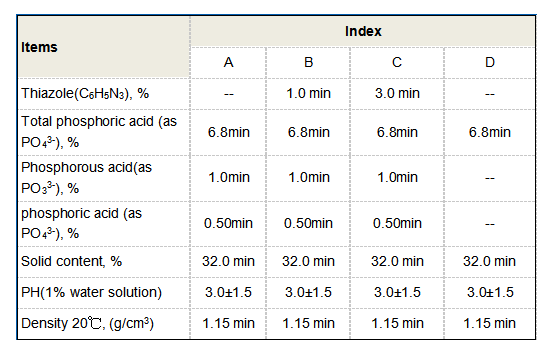Exploring the Role of PBTC Phosphonate in Environmental and Industrial Applications
Understanding PBTC Phosphonates A Key Component in Modern Chemistry
Phosphonates, particularly Phosphonobutane-tricarboxylic acid (PBTC), have garnered significant attention in various fields such as agriculture, industry, and environmental science. Known for their unique chemical properties and applications, PBTC phosphonates play a crucial role in enhancing performance in water treatment, agriculture, and other industrial processes.
The Chemical Structure of PBTC
PBTC is categorized as a phosphonic acid derivative, which contains a phosphonic acid group (-PO₃H₂) in its structure. Its chemical formula is C₇H₁₃O₉P, indicating that it consists of carbon, hydrogen, oxygen, and phosphorus atoms. This chemical configuration allows PBTC to function effectively as a scale inhibitor, chelating agent, and dispersant. The molecule has three carboxylic acid groups that contribute to its hydrophilicity, making it highly soluble in water and effective in various aqueous applications.
Applications in Water Treatment
One of the major applications of PBTC phosphonates is in water treatment systems. Hard water often contains calcium and magnesium ions that precipitate and form scale in pipes and boilers, leading to reduced efficiency and potential damage. PBTC acts as a scale inhibitor by forming stable complexes with these metal ions, thus preventing scale formation and maintaining the efficiency of water systems. This property is particularly valuable in industries such as power generation, oil and gas, and chemical manufacturing, where maintaining equipment efficiency is crucial.
pbtc phosphonate

Role in Agriculture
In agriculture, PBTC phosphonates are utilized as a part of fertilizer formulations and plant protection products. They improve nutrient availability in the soil and enhance the uptake of essential minerals by plants. Phosphonates can also provide a source of phosphorus for plants, a crucial nutrient for plant growth and development. Furthermore, these compounds exhibit antimicrobial properties, which can help in protecting crops from various diseases. Thus, incorporating PBTC in agricultural practices promotes healthier crop yields and sustained soil health.
Environmental Impact and Considerations
While PBTC phosphonates are highly effective, it is essential to consider their environmental impact. The breakdown of phosphonates in various ecosystems is an area of ongoing research. Although PBTC is generally considered more environmentally friendly compared to traditional phosphates, there is a need for responsible usage to prevent potential accumulation in water bodies. Being less biodegradable than other organic compounds, researchers continue to explore ways to mitigate any adverse effects while maximizing its benefits in industrial and agricultural applications.
Conclusion
In conclusion, PBTC phosphonates are indispensable in modern chemistry due to their versatile properties and applications. From preventing scale formation in industrial water systems to enhancing agricultural productivity, PBTC plays a vital role in various sectors. As research progresses, understanding the environmental implications of phosphonate use will be critical to ensure sustainable practices. Effective management and innovative solutions will be necessary to harness the full potential of PBTC phosphonates while minimizing environmental risks. As industries seek eco-friendly alternatives, the role of phosphonates like PBTC will undoubtedly continue to grow, making them a focal point in the quest for sustainable development in chemistry and related fields.
-
Understanding Polycarboxylic Acids: Properties, Applications, and Future PotentialNewsJul.28,2025
-
Scale Inhibitor Explained: How to Protect Your System from Limescale and Hard Water DamageNewsJul.28,2025
-
Scale and Corrosion Inhibitors: Essential Chemicals for Industrial Water System ProtectionNewsJul.28,2025
-
Polyaspartic Acid: A Biodegradable Polymer for Sustainable ChemistryNewsJul.28,2025
-
Isothiazolinones: A Versatile Antimicrobial Class with Industrial Power and Regulatory ChallengesNewsJul.28,2025
-
A Deep Dive into 2-Phosphonobutane-1,2,4-Tricarboxylic Acid (PBTC)NewsJul.28,2025





